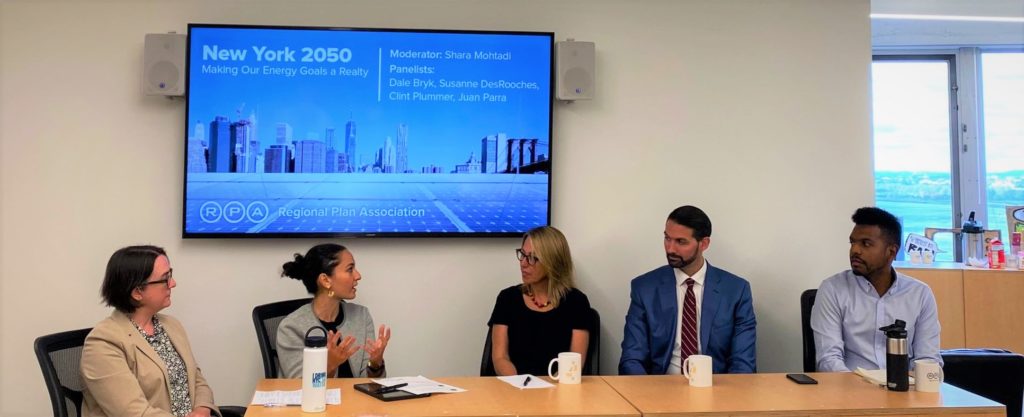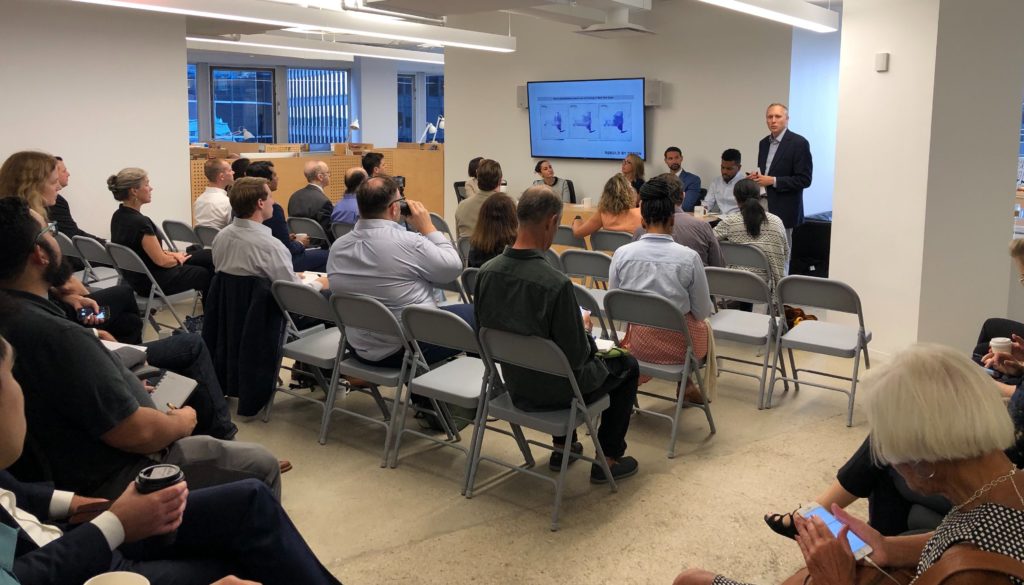Climate change is here and the signs are everywhere across the region. While Superstorm Sandy was a wake-up call for many, it’s no longer just big storms that are impacting our coastlines. This summer we saw the combination of heavy precipitation and aging infrastructure create floods on our streets, buses, and subway stations. Already, more than 100 people are dying annually in New York City from extreme heat. This is becoming the new normal.
Fortunately, we now have some of the most ambitious climate change legislation in the country, with New York City passing its own Green New Deal and the State passing the Climate Leadership and Community Protection Act, which calls for 100 percent carbon-free electricity by 2040 and 70 percent by 2030.
We must mitigate by bringing our greenhouse gas emissions down, and at the same time we must adapt. Therein lies the great challenge. As RPA’s Vice President for Energy and Environment, Rob Freudenberg, asked when he kicked off last month’s New York 2050 panel at RPA; “How do we meet this climate crisis without causing another crisis of energy shortage or affordability or economic decline?” To answer these questions, RPA convened a diverse group of panelists who are on the front lines of the transition to renewable energy. Each agreed that any answer must carefully consider economy and equity.

These panelists included Dale Bryk, Deputy Secretary for Energy & Environment, Office of Governor Andrew M. Cuomo; Susanne DesRoches, Deputy Director, Infrastructure & Energy, NYC Mayor’s Office of Recovery & Resiliency & Office of Sustainability; Clint Plummer, Head of Market Strategies & New Projects - US, Ørsted US; and Juan Parra, Community Solar Program Manager, SolarOne. Shara Mohtadi, Bloomberg Philanthropies’ liaison to the United Nations on climate change, steered the conversation as moderator.
As the senior policy advisor to Governor Cuomo on these issues, Dale Bryk offered a statewide perspective. “We have great transportation here in the city. But when you think about more rural communities upstate, you have people who say, ‘I can’t buy an electric car, but I need to use my car to get to work or school.’ What are the new creative solutions for improving mobility there?” she asked. Bryk described how the administration is focusing on solutions that not only address climate change directly, but have economic development and environmental equity components in order to impact communities holistically.
The panelists unpacked just what equity means in the context of renewable energy. “When I think about equity there’s a backward-looking component and a forward-looking component,” said Juan Parra of SolarOne. “The backwards-looking component is to address the historical disproportionate harm that a lot of communities have faced. A lot of low-income communities, particularly communities of color, have been exposed to more environmental harm and increased energy burdens. So when we look towards the future, it’s about making sure the benefits of legislation such as the CLCPA are serving these communities adequately.”
Parra said his organization wants to get rid of the quotes around disadvantaged communities and actually define who those communities are to ensure they reap the benefits of investment. “We can’t leave the so-called disadvantaged groups - and I don’t really love that word - behind as we move forward.”

As one of the leads for New York City’s government on climate change, Susanne Desroches explained the relationship between energy and equity in the five boroughs right now. “A family is energy overburdened if it spends more than six percent of its income on utilities. More than half a million families in NYC are over that level. We want to make sure the upfront costs and development costs of renewable energy don’t overburden our low-income families.”
Representing Ørsted, the largest owner-operator-distributor of offshore wind in the world, Clint Plummer brought a market-based perspective to the panel. “Investing in technologies that can deliver renewable energy at an affordable cost makes good sense for the communities that we serve and makes good sense for our investors,” he said. Ørsted developed the first offshore wind farm in the United States in Rhode Island and will also construct the first wind farm in each of the three states in RPA’s footprint - Connecticut, New Jersey and New York. “We have to create just transitions for people that are moving out of the fossil fuel industry, and for new people that are coming into the workforce,” he said.
The panelists each described the overall approach of their organization or agency and the small steps they’re taking to rapidly begin this transition to renewable energy. Although the panelists didn’t hone in on one fix-at-all solution, they outlined the scope of the challenge and began to define the conversation. It’s part of a key first step, so that as New York forges its energy future we know what and who to solve for.
To learn more, stream the entire panel here.
